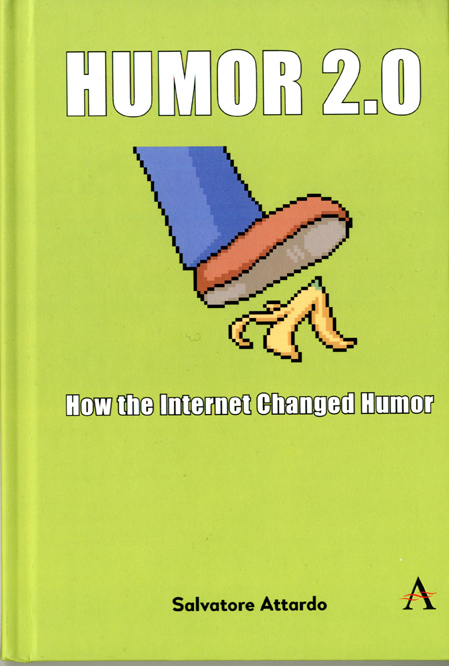HUMOR 2.0
 Attardo, Salvatore, HUMOR 2.0. How the internet changed Humor, London, NewYork, AnthemPress, 2023, 286p.
Attardo, Salvatore, HUMOR 2.0. How the internet changed Humor, London, NewYork, AnthemPress, 2023, 286p.
mot clé : Humour 2.0, internet, mème
Il est passionnant de voir comment Salvatore Attardo, un pilier des études académiques sur l'humour se plonge dans un univers qui n'a rien à voir avec le sérieux universitaire auquel nous sommes habitués. L'auteur adopte un style léger pour évoquer comment lui est venu la nécessité de saisir ces innovations tirées de la culture médiatique américaine (Know your Meme, Wikipedia et autres sites),
mais le reste de l'ouvrage aborde méthodiquement toutes les sortes d'occurrences de ces répliques d'images et de textes à visée distractive. Après avoir exposé les arcanes de la "memetique" (chapitre 2), Attardo rappelle les différentes théories expliquant l'humour (chapitre 3) avant d'aborder ce nouveau langage humoristique (chapitre 4) dont la rapidité de propagation est un signe distinctif. Le cas des "fake news", ces falsifications de vérités, est abordé comme ensuite nombre de particularités propres à la société américaine. En conclusion, Attardo souligne combien ces innovations accentuent un côté grinçant de l'humour produit et brouillent les frontières entre les informations réelles et celles satiriques, entre la plaisanterie et les propagandes suprématistes. De même, les détournements par leur mise en scène de colère et de frustration majorent la volonté de moquer ou d'agresser ("uglification" of Humor). Enfin il est à noter en conclusion la référence à Guy Debord et sa Société du spectacle dont les créations Web2.0 seraient un exemple de réalisation.
Présentation éditoriale :
The book shows how humor has changed since the advent of the internet: new genres, new contexts, and new audiences. The book provides a guide to such phenomena as memes, video parodies, photobombing, and cringe humor. It also shows how the cognitive mechanisms of humor remain unchanged.
Table des matières :
Introduction; 1.Humor and the Internet; 2.Memetics; 3.Humor Theory; Part 1.New genres; 4.The New Language of Humor; 5.The Compilation; 6.Internet Cartoons; 7.Stuff White People Like; 8.Dogecoin, the Joke Currency; 9. The Spoiler Alert; 10.Satirical News Websites and Fake News; Part 2.Memes and More Memes; 11.Memetic Drift or The Alliteration Arsonist; 12.The Saga of Boaty McBoatface; 13.A General Theory of Grumpy Cats; 14.The Pastafarian Memeplex: Joke Religion as a System; 15.When Chuck Norris Is Waiting, Godot Comes; 16.The Half-life of a Meme: The Rise and Fall of Memes; Part 3.Multimodality; 17.Hitler’s Opinion on the Parking Situation in Tel Aviv; 18.Photobombing as Figure Ground Reversal; 19.“Hard to Watch”: Cringe and Embarrassment Humor ; 20.Humor Videos; 21.Reaction Videos; Part 4.The Dark Side of Internet Humor; 22.The Use of Humor by the Alt-Right; 23.4chan, Trolls and Lulz: Fascists at Play; 24.Pepe, Kek and Friends; Conclusion: Plus ça change…; Bibliography; Author; Index; Subject Index
https://anthempress.com/humor-2-0-hb
The book provides a comprehensive discussion of the new humor that has appeared on the internet. The book is divided into five sections: First, the introduction, which explains the idea that humor has changed since the widespread adoption of the internet and social media. The introduction reviews the theoretical tools that will be applied throughout the book: a discussion of humor theory and memes and how they function. The discussion is kept engaging and readable but is nonetheless based on rigorous scholarship, presented clearly by a well-known humor researcher.
Part 1 collects several chapters on the new humorous genres that have appeared on the internet: the humorous meme, the compilation video, online digital cartoons, the “stuff white people like” phenomenon, Dogecoin, the joke crypto-currency, and of course satirical news, such as The Onion. The overall point is that many of these phenomena are completely native to the internet/social media or have been significantly affected by the distribution via the internet.
Part 2 considers in more detail a number of examples of humorous memes: they include the Cheryl She Shed meme, the BoatyMcBoatface incident in which the crowdsourcing of the name for a boat went awry, Pastafarianism, the joke religion, grumpy cats, and the Chuck Norris memes. Part 3 considers multimodal humorous genres: the Hitler rant, photobombing, embarrassment (“cringe”) comedy, rant-to-music videos, and music video parodies. Here too, these new genres can exist only due to the availability of platforms such as Youtube or TikTok. Part 4 looks at the dark side of internet humor, considering the use of humor by the alt. right on 4chan and 8chan, trolling, and related phenomena. The last chapter looks at humorous cartoon “mascots” such as Pepe the Frog and Kek, which have been appropriated by the right.
The first comprehensive guide to humor in the age of the internet and social media, this book will make you laugh (for the examples) and will enlighten you (for the analyses). Hopefully.
